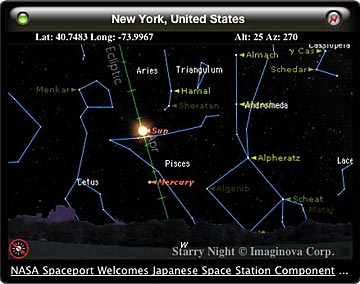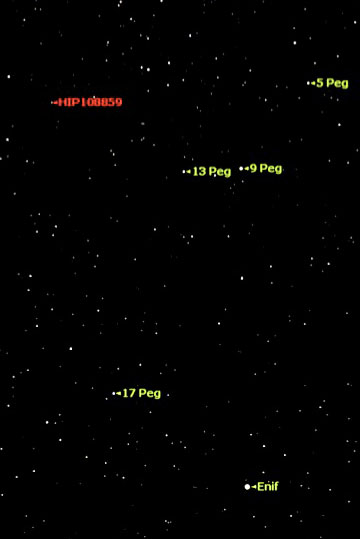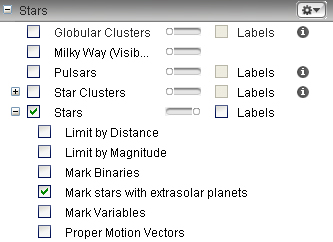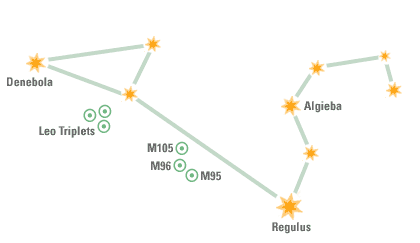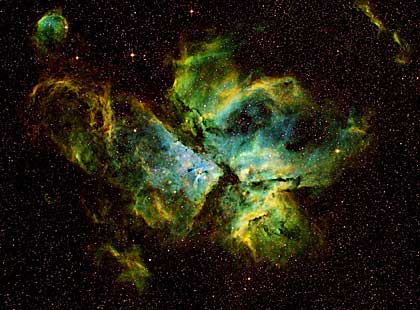 |
||||||||||||||||||||||||||||||||||||||||||||||||||||||||||||||||||||||||||||||||||||||||||||
|
If you have trouble viewing this newsletter, click here. Welcome again to our monthly newsletter with features on exciting celestial events, product reviews, tips & tricks, and a monthly sky calendar. We hope you enjoy it!
New Features in Version 1.1.0 include:
Linda Fung
Discover the Research-Proven Best Way to Teach Space Science and Meet Standards! First released in 2005, award-winning Starry Night® Middle School and High School are the only space science curricula that combine an interactive sky simulator, lesson plans correlated to state and national standards and extensive teacher resources in one easy-to-use package. Starry Night® Middle School and High School have already been adopted as instructional materials in states such as Arkansas and New Mexico. Winner of ComputED’s Best Educational Software Award, Starry Night® Middle School and High School have been hailed by reviewers and educators for providing “such unique and compelling experiences that it is destined to change lives.” Starry Night® Elementary continues this tradition of academic excellence, offering grade-appropriate lesson plans, realistic 3-D simulations and hands-on manipulatives that teach the fundamentals of space science and the scientific process.
Only Starry Night® Middle School and High School include a 3-ring binder of up to 450 pages of lesson plans that meet state and national standards and incorporate hands-on activities and computer exercises. Written by teachers for teachers, each lesson plan clearly outlines the learning objectives, conceptual background, hands-on activities, and teaching strategies. Reproducible student worksheets and assessment tools make it easy to evaluate student comprehension. What makes the curriculum versions of Starry Night® unique is the integration of the student worksheets into the Starry Night® software. The student exercises are programmed into the SkyGuide and trigger the launch of Starry Night® simulations. We've created hundreds of Starry Night® simulations that best illustrate astronomy concepts. You no longer need to spend time choosing locations, viewing options or time settings - we have done it for you! Click on links in the Student Exercises section of the SkyGuide to instantly access 3-D views of the solar system, the view of an eclipse from the Sun, the cause of seasons, the flight path of Cassini-Huygens and more. Starry Night® Elementary, Middle School and High School are based on the latest Starry Night® version 6 software. Starry Night® Elementary will be released in June 2007 and will include a three-ring binder with up to 100 pages of lesson plans.
All curriculum versions of Starry Night® include:
In Starry Night® Middle School and High School, the lessons are divided into 9 units:
Each lesson plan is correlated to grade level and national and state/province standards so that teachers can choose the ones that best fit their curriculum requirements and classroom needs. The purchase of a single copy of Starry Night® Elementary, Middle School and High School allows you to install and use the software on 1 computer. If you want to install a Starry Night® curriculum version on more than 1 computer, you must purchase a multi-seat license. How do I purchase or upgrade to the new editions of Starry Night® Middle School and High School? You can purchase single user versions of Starry Night® Middle School or High School directly from Starry Night® online. For a customized quote or to purchase upgrades to Starry Night® curriculum versions or multi-seat licenses, please contact Mike Goodman by phone 877-290-8256 toll-free, by fax 952-935-4050 or by email mgoodman@space.com.
Starry Night® Middle School has a 385-page teacher binder with 28 lesson plans and contains all the functionality and content of Starry Night® Enthusiast version 6. Starry Night® High School has a 450-page teacher binder with 30 lesson plans and contains all the functionality and content of Starry Night® Pro version 6, which can control a telescope. Starry Night® Elementary will have a 100-page teacher binder with 7 lesson plans and all the functionality and content of Starry Night® Enthusiast version 6. We have created grade-specific lesson plans and activities that address the different learning needs of students in grades K-2 and grades 3-4. I already own Starry Night® version 6 software. Can I buy the Teacher Guide without the software? No. The curriculum versions are built to run with custom configured software. Using the Teacher’s Guide with other versions of Starry Night® or without the software at all would not adequately explain the lesson plans and you would not have access to the pre-set Starry Night® simulations. I already own Starry Night® Middle School and High School. What’s new? The new content highlights the latest theories and addresses classroom needs:
The software in Starry Night® Middle School and High School has been upgraded from version 5 to version 6. It is now Macintosh OS X Universal Binary and Windows Vista compatible. My school (or my child’s school) only teaches a short unit on space science. How do I use Starry Night® in this situation? The Starry Night® lessons are entirely modular so you can choose the lessons that best meet your curriculum requirements. This flexible teaching model accommodates diverse learning styles and easily adapts to pacing and classroom needs. The resources in Starry Night® Middle School and High School give teachers multiple ways to engage students in astronomy as never before. 4 Easy Ways to Order Call Mike Goodman toll-free 877-290-8256 Linda Fung
The first International Sidewalk Astronomy Night will be held on Saturday, May 19, 2007. This is a new initiative, not to be confused with International Astronomy Day, which took place on April 21. The main difference between these two events is where they take place. On International Astronomy Day, clubs, observatories, and planetariums open their doors to the public for a variety of events. The catch is that they take place on the organizations’ home turf, and the public is expected to find out about these events, to seek them out. International Sidewalk Astronomy Night takes its cue from the John Dobson’s original idea of Sidewalk Astronomy: taking telescopes to the people. John Dobson, inventor of the Dobsonian telescope, had the idea back in 1968 of setting up telescopes where people congregate: on the streets of the city, in shopping mall parking lots, outside movie theatres, in city parks. This started originally in San Francisco, but the idea has spread widely. While often organized in clubs, it can also be undertaken by one or two enthusiastic amateurs on their own. For example, a number of us have used Hallowe’en as a time to set up our telescopes on about the only night of the year when there are large numbers of pedestrians in suburban neighborhoods. This year on Saturday May 19, the Sidewalk Astronomers www.sidewalkastronomers.us are inviting amateur astronomers around the world to set up their telescopes in places where people congregate: This web page contains detailed information on how to proceed, and includes materials for preparing handouts for the public. They’re inviting people to sign up on their web site so that they can get some idea of the numbers involved: so far well over a hundred individuals and clubs have joined in the effort. There are participants on all of the world’s continents except for Antarctica…not too many pedestrians there! May 19 should be a comfortably mild night in most locations. Venus and a four-day-old Moon will be close to conjunction in the west, with Saturn high above them, so there will be plenty to look at even in the most light-polluted locations. Deep sky objects are usually less popular with the public, especially in the face of light pollution, but the globular clusters M3 and M13 might be worth a look. If you’ve never used your telescope to show off the sky to the public, this will be a wonderful opportunity to “share the skies”! Geoff Gaherty
Have you ever seen an asteroid? No, not one in a computer game, but one of the thousands of small bodies orbiting the Sun between the orbits of Mars and Jupiter. This month will be a great opportunity to see one. The first asteroid Ceres (reclassified as a Dwarf Planet in 2006) was discovered by Giuseppe Piazzi on January 1, 1801, the first day of the 19th century; at 957 km in diameter it is the largest asteroid. Vesta was the fourth asteroid discovered six years later in 1807 by Heinrich Wilhelm Olbers. Although at 512 km diameter only half the size of Ceres, it is significantly brighter because of its unusually bright surface material, making it by far the brightest asteroid, the only one visible (barely) to the naked eye. This month Vesta will be located in the constellation Ophiuchus, roughly 10 degrees northwest of Jupiter. It begins the month at magnitude 5.4, located half way between the 2nd magnitude stars Sabik and Han (Eta and Zeta Ophiuchi), gradually brightening to magnitude 5.2 and moving westward, ending the month about half way between Han and Phi Ophiuchi. This will place it exactly 1 degree south of the bright globular cluster Messier 107, making an interesting pairing in any telescope. When near opposition on May 30, it will be moving almost a quarter of a degree each day, so plotting its position relative to surrounding stars on successive nights will make its identification very easy. Under clear dark skies, the human eye can see down to about 6th magnitude, so that Vesta should be just detectable with the naked eye in May and June. Any sort of optical power, such as a small binocular, will make it easy to see and identify. Use Starry Night® to plot its position from night to night to help in finding it. Here, for example, is a plot of the objects discussed for May 30:
Geoff Gaherty
The first confirmed discovery of a planet revolving around a star other than the Sun was made less than 30 years ago by Canadian astronomers Bruce Campbell, G. A. H. Walker, and S. Yang. Since then, more than 200 more so-called exoplanets have been discovered. Most of the stars with known planets are fairly faint, and known mainly by their catalog number. One of the most interesting has been the planet HD209458b, which revolves around the 8th magnitude star HD209458 in the constellation Pegasus. This planet, nicknamed Osiris after the Egyptian god, was discovered in 1999, and was the first known exoplanet to transit its star regularly. In other words, its orbit is such that the planet passes between us and its star once a “year”, its year being 3.5 Earth days long. Its spectrum has been studied by the Hubble Space Telescope, and is known to contain water. Like all stars except the Sun, HD209458 is too far away to show a disk, appearing in the largest telescopes as a point of light. But, simply because it’s known that this star has a planet with water, there is a real fascination of seeing it with our own eyes and, with the help of Starry Night® and a small telescope, this is quite possible.
HD209458 is also known as HIP108859, and it is under that catalog number that you can find it in Starry Night. It is visible at present in the morning sky, between the stars 9 and 33 Pegasi in one of the “legs” of the winged horse Pegasus. You can find it easily by starting at the bright star Enif, Epsilon Pegasi. Sweep 7 degrees north to find 9 Pegasi, 4th magnitude. Look for 5th magnitude 13 Pegasi a little over a degree east of 9 Pegasi. From there, HIP108859 is 3.5 degrees northeast. This star is very similar in size and color to our Sun, but is located 154 light years away. How to Mark Stars With Extrasolar Planets
Geoff Gaherty
Leo is a large constellation, some 30° across, and well-placed for observation at this time of year, high above the southern horizon. The first of Hercules' fabled twelve tasks was to bring King Eurystheus the skin of a terrible lion whose hide was known to be invulnerable to spears and arrows. Hercules didn't have much bother with the lion: he cornered the beast in its lair and strangled it to death by ramming his fist down its throat. When he returned with the lion's body, the King was so terrified he ran from the sight of it. Hercules wasn't fazed: he skinned the lion and took its hide as armor. The Leo "Triplets" (M65, M66 and NGC 3628) are a nice grouping. The two Messier objects are brighter but the third triplet is visible too and, if you use averted vision, surprisingly large; it looks elongated and edge-on-ish. In the same field of view, the whole grouping looks like eyes and a mouth. M95, M96 and M105 are not so bright, but make an interesting group for comparison. Regulus, the brightest star in Leo and the 21st brightest star in the sky, has a faint double sometimes visible in binoculars. Algieba is one of the best doubles in the sky, with two yellow components that orbit one another every 620 years. Denebola, a blue-orange pair, is an optical double: the stars are far apart in space, not connected in any way, but lie along the same line of sight. Sean O'Dwyer
Photo of Eta Carina taken by Phillip Holmes with an STL-11000M Televue NP101mm F/5.4 on G11 mount; 2 x 20mins each channel in S11, HA, O111.
PRIZES AND RULES: We would like to invite all Starry Night® users to send their quality astronomy photographs to be considered for use in our monthly newsletter.
Please read the following guidelines and see the submission e-mail address below.
|
MAY 2007
|
|||||||||||||||||||||||||||||||||||||||||||||||||||||||||||||||||||||||||||||||||||||||||||
 |
||||||||||||||||||||||||||||||||||||||||||||||||||||||||||||||||||||||||||||||||||||||||||||
|
Minimum purchase of $45.00 USD is required. Offer expires April 30, 2007 12:00 PM Noon EST. Limit 1 FREE Star Target Planisphere per 1 purchase of any upgrade or full box copy of Starry Night® Version 6. This offer applies to Starry Night® Enthusiast, Starry Night® Pro, Starry Night® Pro Plus and Starry Night® AstroPhoto Suite. All prices are quoted in USD. Not valid on previous purchases. © 1999-2007 Imaginova® Corp. All Rights Reserved. |
||||||||||||||||||||||||||||||||||||||||||||||||||||||||||||||||||||||||||||||||||||||||||||
You have received this e-mail as a trial user of Starry Night® Digital Download
or as a registrant at starrynight.com. To unsubscribe, click here.
